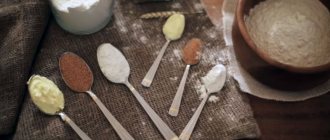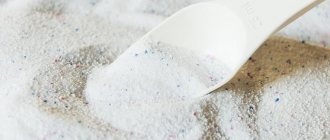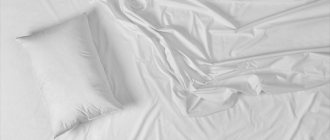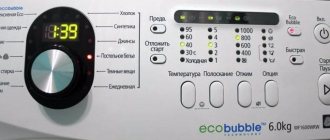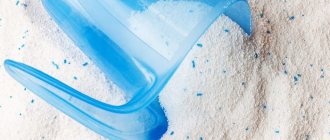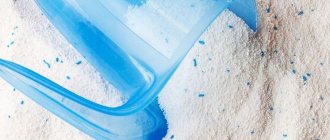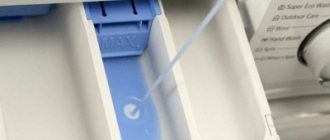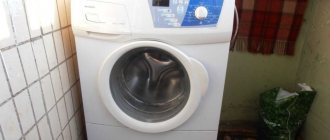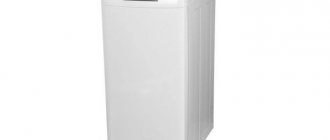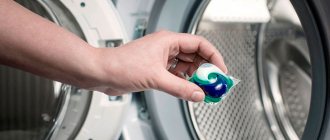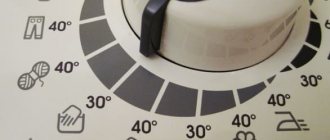How many grams are in spoons? Let's figure it out.
You wanted to cook something and have already found a recipe on the Internet. But here difficulties arose due to the fact that you do not have a kitchen scale. This is not a problem if you know how many grams are in a tablespoon, teaspoon and dessert spoon.
The most important thing is that spoons are much easier and more convenient to use than scales. Very often people wonder how many grams are in a tablespoon of sugar, flour and dry yeast. In this article you will find complete answers to your questions.
- teaspoon , 5 ml is approximately 5 grams;
- dessert spoon - 10 ml liquid - 10 grams;
- tablespoon - 15 ml liquid - 15 grams.
How can you measure the weight of food?
- scales
- steelyard
- measuring cup
- measuring spoon (jug) with electronic scales
- teaspoon
- tablespoon
- faceted glass
- thin-walled glass
- a special set of measuring spoons (you can even buy them at Fix Price)
Show slideshow
Why recalculate
The most convenient tool for converting ml to grams is a measuring spoon with built-in scales. But, unfortunately, not every home will have one.
Most housewives are often faced with the need to convert milliliters to grams and back in the kitchen when preparing complex recipes. This is necessary when there are no exact scales at hand, but there are spoons, the volume of which is more or less known. And vice versa, when there are no measuring utensils, but there are accurate kitchen scales.
Cooks often believe that 10 ml is 10 grams. However, in fact, this statement is only true for water and substances with the same density. There are actually 10 grams of them in 10 ml. And for all other substances it is necessary to recalculate. If you don’t have a measuring cup, you can convert weight to volume and back using special tables, formulas, or search the Internet for an online calculator.
Rules for using home weights
- Fill the glasses with liquid to the very brim
- Typically, in cooking, two types of glasses are used for measuring: faceted (200 ml) and thin-walled (250 ml)
- Apply viscous and thick mixtures, for example, honey, jam, with a spoon, so that there are no free cavities left. For the same reason, we spoon the flour rather than pour it from a bag, otherwise cavities will form in the glass
- One more nuance about flour - do not weigh it after sifting, it will be much lighter
- Pour bulk products heaped
- Watch the quality of the products, raw salt and sugar will be much heavier, but expired sour cream is lighter
Why do you need to know the dosage of the powder?
When loading a machine, not many people think about how much powder is required. Housewives usually add the amount of product indicated on the packaging by the manufacturer. The manufacturing company often exceeds the required standards for washing powder, thereby forcing customers to purchase their product quite often. Therefore, with some simple knowledge, you can save on purchasing detergents and extend the life of your equipment.
Washing powder norm
Some believe that a large amount of detergent placed in the compartment will help wash clothes better. It's not like that at all.
If you use detergent in excess, this can lead to negative consequences:
- the powder will not be washed off completely, as a result of which the clothes will have white stains;
- the tray will not be washed and will become clogged over time;
- An unpleasant odor will remain in the drum.
How many grams in a teaspoon
| 1 teaspoon | Product type | Spoon without slide | Heaped spoon |
| 1 teaspoon | flour | 9 grams | 12 grams |
| 1 teaspoon | sugar | 5 grams | 8 grams |
| 1 teaspoon | powdered sugar | 10 grams | 13 grams |
| 1 teaspoon | fine salt | 7 grams | 10 grams |
| 1 teaspoon | soda | 7 grams | 10 grams |
| 1 teaspoon | rice | 5 grams | 8 grams |
| 1 teaspoon | coffee | 4 grams | 7 grams |
| 1 teaspoon | honey | 10 grams | 12 grams |
| 1 teaspoon | dry yeast) | 2.5 grams | 3 grams |
| 1 teaspoon | cocoa | 6 grams | 9 grams |
| 1 teaspoon | cinnamon | 5 grams | 8 grams |
| 1 teaspoon | gelatin (granules) | 5 grams | 8 grams |
| 1 teaspoon | citric acid | 5 grams | 8 grams |
| 1 teaspoon | water | 5 grams | |
| 1 teaspoon | vinegar | 5 grams | |
| 1 teaspoon | milk | 5 grams | |
| 1 teaspoon | vegetable oil | 5 grams | |
How many grams in a glass
Nowadays, there is a huge variety of glasses, but in cooking, as a rule, a faceted glass is taken as the basis, so the grams of the faceted glass will be indicated in the table below
| 1 faceted glass | Product type | Grams |
| 1 glass | water | 200 grams |
| 1 glass | vegetable oil | 180 grams |
| 1 glass | ghee | 190 grams |
| 1 glass | cream | 210 grams |
| 1 glass | flour | 130 grams |
| 1 glass | Sahara | 190 grams |
| 1 glass | salt | 200 grams |
| 1 glass | rice | 190 grams |
| 1 glass | honey | 280 grams |
Drops
To understand how many drops are in 1 ml of solution, you first need to decide what a drop is.
A drop is a small (or minimal) volume of a liquid substance, whose shape and boundaries are determined by the influence of surface tension. The drops are spherical or oval in shape.
The drop itself is a fairly approximate unit. And it is clear to the naked eye that drops of even one substance can be different in size, and therefore in the volume of the solution in them. To avoid large errors, doctors and pharmacists decided to take a drop volume of 0.05 ml as the standard. Based on this, 1 ml corresponds to 20 drops. This is approximately how many drops are contained in 1 ml of aqueous solution.
By multiplying the volume by 20, you can find out the number of drops in this volume. Conversely, knowing the number of drops, you can find out the volume of a particular liquid. To do this, the number of drops should be divided by 20.
But even such a calculation will be quite rough, and it is suitable mainly for aqueous compositions. For alcohol solutions and tinctures, 1 ml is about 50 drops, and for essential oils - about 10-15 drops.
To find out how many drops are in 1 ml of various substances, you can also use the official documentation where this is published.
Measuring tables for various products
Measuring table of bulk products
| Product name | Faceted glass - 200 ml (g) | Thin glass - 250 ml (g) | Table spoon | teaspoon |
| FLOUR AND GREATS | ||||
| Wheat flour | 130 | 160 | 20 | 10 |
| Semolina | 150 | 200 | 16 | 4 |
| Buckwheat | 170 | 200 | 20 | 5 |
| Pearl barley | 200 | 230 | 23 | 6 |
| Millet groats | 190 | 225 | 20 | 5 |
| Jan cereal | 190 | 225 | 20 | 5 |
| Oatmeal | 130 | 170 | 18 | 5 |
| Corn grits | 145 | 180 | 20 | 6 |
| Oatmeal (Hercules) | 70 | 90 | 12 | 3 |
| OTHER BULK PRODUCTS | ||||
| Peas | 190 | 230 | 20 | 5 |
| Gelatin | ———— | ———— | 15 | 5 |
| Starch | 130 | 160 | 30 | 10 |
| Coffee | ———— | ———— | 20 | 10 |
| Cocoa | ———— | ———— | 15 | 5 |
| Lemon acid | 250 | 300 | 30 | 10 |
| Poppy | 125 | 155 | 15 | 5 |
| Baking powder | ———— | ———— | 15 | 5 |
| Rice | 180 | 240 | 30 | 10 |
| Powdered sugar | 140 | 190 | 24 | 8 |
| Fine salt | 320 | 400 | 30 | 10 |
| Granulated sugar (sugar) | 160 | 200 | 25 | 7 |
| Soda | 160 | 200 | 28 | 12 |
| Beans | 190 | 230 | 20 | ———— |
| Lentils | 190 | 210 | ———— | ———— |
Measuring table for liquid and paste products
| Product name | Faceted glass - 200 ml | Thin glass - 250 ml | Table spoon | teaspoon |
| Jam | 270 | 325 | 35 | 15 |
| Water | 200 | 250 | 15 | 5 |
| Yogurt | 250 | ———— | 20 | 10 |
| Kefir, fermented baked milk | 250 | ———— | 18 | 6 |
| Mayonnaise | 260 | ———— | 25 | 8 |
| Honey | ———— | ———— | 21 | 17 |
| Milk | 200 | 250 | 15 | 5 |
| Liquor | ———— | ———- | 20 | 7 |
| Vegetable oil | ———— | ———— | 17 | 5 |
| Cream | 200 | 250 | 15 | 5 |
| Sour cream | 210 | 260 | 25 | 10 |
| Condensed milk | ———— | ———— | 30 | 12 |
| Creamy melted butter | ———— | ———— | 25 | 8 |
| Soy sauce | 230 | ———— | 21 | 7 |
| Tomato paste | ———— | ———— | 30 | 10 |
| Table vinegar | 200 | 250 | 15 | 5 |
How many milliliters of liquid are in a spoon or glass?
- How many ml in a tablespoon? 15 ml in a tablespoon = 3 teaspoons
- How many ml in a teaspoon? 5 ml in a teaspoon
- How many ml are in a dessert spoon? In a dessert spoon 10 ml = 2 teaspoons
- How many ml are in a faceted glass? In a faceted glass 200 ml
- How many ml are in a tea (thin) glass? 250 ml in a tea glass
Measuring table of berries, fruits, dried fruits
| Product name | Faceted glass - 200 ml | Thin glass - 250 ml | Table spoon | teaspoon |
| Peanut | 140 | 175 | 25 | 8 |
| Cowberry | 110 | 140 | 20 | ———— |
| Cherry | 130 | 165 | ———— | ———— |
| Walnut | 130 | 165 | 30 | 10 |
| Blueberry | 160 | 200 | 25 | ———- |
| Blackberry | 150 | 190 | 30 | ———- |
| Raisin | 155 | 190 | 25 | 7 |
| Pine nut | 110 | 140 | 10 | 4 |
| Strawberry | 120 | 150 | 25 | ———- |
| Cranberry | 115 | 145 | 25 | ———- |
| Gooseberry | 165 | 210 | 35 | ———— |
| Raspberries | 145 | 180 | 30 | ———- |
| Almond | 130 | 160 | 30 | 10 |
| Sunflower seeds | 135 | 170 | 25 | 8 |
| Black currant | 125 | 155 | 25 | 8 |
| Red currants | 140 | 175 | 30 | 10 |
| Pumpkin seeds | 95 | 125 | 20 | 7 |
| Hazelnut | 130 | 160 | 30 | 10 |
| Fresh blueberries | 160 | 200 | 35 | ——— |
| Dried blueberries | 110 | 130 | 15 | ———- |
| Dried rose hips | ———- | ——— | 20 | 7 |
Measuring weight table for vegetables and other products
| Product name | Weight of 1 product in grams |
| Apricot | 40 |
| Orange | 140 |
| Eggplant | 200 |
| Pear | 135 |
| Strawberries | 8 |
| White cabbage | from 1500 |
| Potatoes (medium size) | 100 |
| Lemon | 50-70 |
| Onion (medium size) | 75 |
| Carrots (medium) | 75 |
| Cucumber (medium) | 100 |
| Peach | 85 |
| Tomato | 75 |
| Radish | 20 |
| Radish | 170 |
| Turnip | 85 |
| Plum | 30 |
| Apple | 90 |
| Egg C0 | 55-60 |
| Egg C1 | 50-55 |
| Egg C2 | 40-45 |
| Egg yolk | 20 |
| Egg white | 30 |
Oils
Modern hypermarkets offer customers olive, sunflower, corn and many other types of oil. Each individual species has its own characteristics and chemical composition. The oil is used to prepare first courses, desserts, meat, and baked goods. You should not add more of this substance than normal; it is important to maintain the proportions to obtain not too fatty, healthy food. How much oil is in a teaspoon depends on the specific type. The average is 6 g.
Powders are still the most popular laundry detergents. In order to wash clothes well without using too much detergent, users try to accurately measure the dose specified by the manufacturer. Let's find out how many grams of powder are in a spoon - the simplest measuring device available in every home.
Foreign weights
My husband and I often like to look at foreign sites about food and take some recipes into service, but there is a small catch - they have different weight measures. For example, in addition to quarts, pints and ounces, they do not measure in glasses; instead they use cups, which, you see, is not usual for us and cannot be compared in any way with the volume of our glass. Therefore, we present foreign weight measures.
American volume measures
| 1 cup | 250 ml |
| 1/4 cup | 60 ml |
| 1/2 cup | 125 l |
| 2/3 cup | 170 ml |
| 3/4 cup | 190 ml |
| 1 tsp (1 tsp) | 5 ml |
| 1 tbsp. (1 tbsp) | 15 ml |
| 1 pint | 470 ml |
| 1 quart (1 qt, qwart) | 950 ml |
| 1 fl. oz. (1 fl. oz.) | 30 ml |
English volume measures
| 1 cup | 280 ml |
| 1 tsp (1 tsp) | 6 ml |
| 1 tbsp. (1 tbsp) | 17 ml |
| 1 pint | 570 ml |
| 1 quart (1 qt, qwart) | 1100 ml |
Weights
| 1 ounce (1 ounce) | 28.3 g |
| 1 pound | 450 g |
Are grams and milliliters the same thing or not?
Is it really true, as some housewives believe, that 100 milliliters is the same as 100 grams ? Here you should clearly define the terminology:
- Gram (g) is a unit of mass, milliliter (ml) is a unit of volume.
- 1 milliliter in the international system of units (SI) corresponds to 1 cubic centimeter.
The ratio of mass and volume depends on the density of the substance. The easiest way to calculate it is for pure water: its density is 1 g/ml . Therefore, 100 g of water is really equal to 100 ml. However, for water that is too cold or too hot, the ratio will change, although only slightly. To calculate the volume of other substances, you will need to know its density. Thus, the density of milk is 1.03 g/m2 - very close to that of water, and the density of flour is 0.57 g/m3 , which makes it impossible to simply identify volume and mass. After all, 1 g of flour will contain more than 2 ml.
